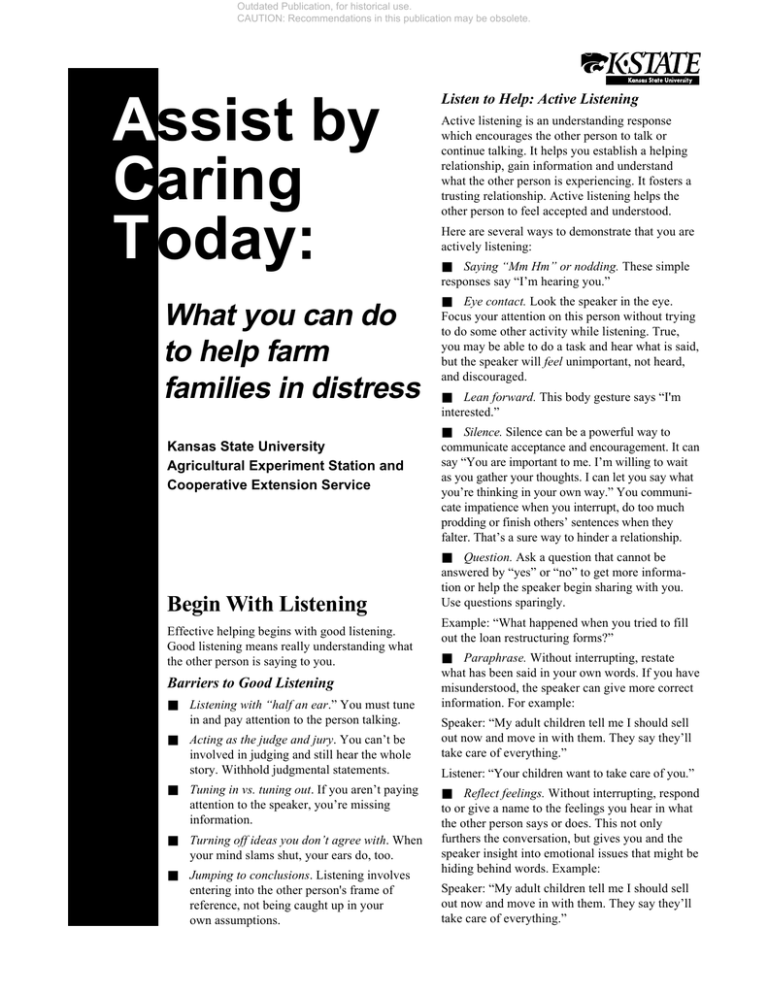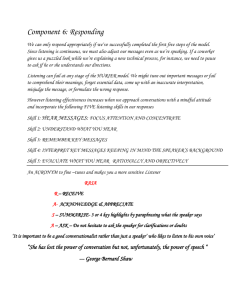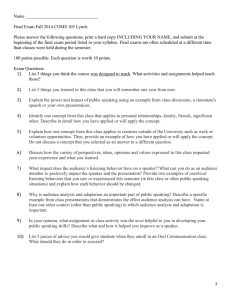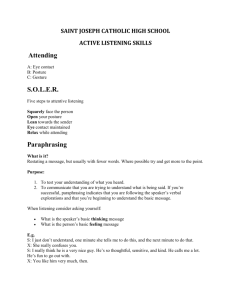
Outdated Publication, for historical use.
CAUTION: Recommendations in this publication may be obsolete.
Assist by
Caring
T oday:
What you can do
to help farm
families in distress
Kansas State University
Agricultural Experiment Station and
Cooperative Extension Service
Begin With Listening
Effective helping begins with good listening.
Good listening means really understanding what
the other person is saying to you.
Barriers to Good Listening
■
■
Listening with “half an ear.” You must tune
in and pay attention to the person talking.
Acting as the judge and jury. You can’t be
involved in judging and still hear the whole
story. Withhold judgmental statements.
■
Tuning in vs. tuning out. If you aren’t paying
attention to the speaker, you’re missing
information.
■
Turning off ideas you don’t agree with. When
your mind slams shut, your ears do, too.
■
Jumping to conclusions. Listening involves
entering into the other person's frame of
reference, not being caught up in your
own assumptions.
Listen to Help: Active Listening
Active listening is an understanding response
which encourages the other person to talk or
continue talking. It helps you establish a helping
relationship, gain information and understand
what the other person is experiencing. It fosters a
trusting relationship. Active listening helps the
other person to feel accepted and understood.
Here are several ways to demonstrate that you are
actively listening:
■ Saying “Mm Hm” or nodding. These simple
responses say “I’m hearing you.”
■ Eye contact. Look the speaker in the eye.
Focus your attention on this person without trying
to do some other activity while listening. True,
you may be able to do a task and hear what is said,
but the speaker will feel unimportant, not heard,
and discouraged.
■ Lean forward. This body gesture says “I'm
interested.”
■ Silence. Silence can be a powerful way to
communicate acceptance and encouragement. It can
say “You are important to me. I’m willing to wait
as you gather your thoughts. I can let you say what
you’re thinking in your own way.” You communicate impatience when you interrupt, do too much
prodding or finish others’ sentences when they
falter. That’s a sure way to hinder a relationship.
■ Question. Ask a question that cannot be
answered by “yes” or “no” to get more information or help the speaker begin sharing with you.
Use questions sparingly.
Example: “What happened when you tried to fill
out the loan restructuring forms?”
■ Paraphrase. Without interrupting, restate
what has been said in your own words. If you have
misunderstood, the speaker can give more correct
information. For example:
Speaker: “My adult children tell me I should sell
out now and move in with them. They say they’ll
take care of everything.”
Listener: “Your children want to take care of you.”
■ Reflect feelings. Without interrupting, respond
to or give a name to the feelings you hear in what
the other person says or does. This not only
furthers the conversation, but gives you and the
speaker insight into emotional issues that might be
hiding behind words. Example:
Speaker: “My adult children tell me I should sell
out now and move in with them. They say they’ll
take care of everything.”
Outdated Publication, for historical use.
CAUTION: Recommendations in this publication may be obsolete.
Listener: “ You’re not sure you want to do that.”
Or, “Does that feel scary (or like giving up)?”
Beyond Listening
As you listen and learn more about the speaker’s
situation, you may want to help. A good place to
begin is by offering supportive statements.
Respond to the speaker with a touch or a comment
that offers encouragement or acceptance of the
speaker’s thoughts, ideas and feelings.
For example, your client may confide “I feel like
I’m going to drown in all this debt!” Your reply
can help the person feel that he or she is not
alone:“I certainly understand why you feel that
way. I think it’s normal.”
Several rural assistance persons around the state
invite families together on a regular basis for
refreshments, discussion and (sometimes) informative speakers. Many farm couples have talked
of the importance of these support groups as they
seek new solutions.
Think about it—what can you do to be more
supportive of the farm and rural families in
your area?
Things to Think About:
■
How do you feel when others don’t seem to
be listening and really hearing what you say?
■
Occasionally, you may need to confront a client
with the contradiction you see between words and
behavior. Interpreting the situation can help your
client face unexpressed feelings.
What can you do if you feel someone is not
really listening and hearing what you have
to say?
■
What is one listening skill you want to try
more often at home? At work?
For example, your client may be telling you how
pleased she is that her situation is working out a
particular way. But all the while, you notice how
she looks sad and dejected. Your reply of “You’re
telling me how happy you are, but you look pretty
upset” can open doors of insight for your client
that can lead to healing the hurts. It can also give
you an opportunity to hear what the real issues are.
■
What can you do to be more supportive of
the farm families in your area?
For more information:
Guide your client in determining what the actual
problems are. Your client may feel like a spouse
or another person is the problem. Is the problem
really the person or the person’s behavior? Maybe
even circumstances? When we blame a person for
our difficulties, we are effectively tearing down a
relationship without solving the problem. Help
your client focus on the source of the difficulties.
Guide your client in considering courses of action
or resources for help. If your client’s needs fit
your skills, perhaps you can help. Quite often the
problem can’t be solved by you or the person
you’re helping. In these situations, it is best to
refer the person to someone else or to a group who
can offer more specific assistance. This may be
professional help (legal, financial, emotional,
spiritual) or perhaps a support group or a supportive person.
Do not hesitate to admit that you don’t know how
to solve the problem. Just be willing to help the
person find someone who might know. As you
make the referral, remind your client that you do
care. You care enough to want the best possible
help or service for that person.
Your most important gift to your clients is your
listening, your acceptance and your sincere
interest in them. To know you are not alone gives
courage.
Charlie Griffin, Rural Family Support Specialist,
Farmers Assistance, Counseling and Training
Service (FACTS), 9 Leasure Hall, Kansas State
University, Manhattan, KS 66506
1-800-321-FARM or 913/532-6958.
When You’re Over Your H
Here’s when to refer your client:
1. when you feel persistently uncomfortable;
2. when you believe that improvement is
“impossible” or the situation is “hopeless”;
3. when the person you visit with says,
“nothing is helping” or what you provide
the person isn’t helping;
4. there is an obvious change in speech,
appearance;
5. the person continues to be so emotional
he or she can’t communicate;
Outdated Publication, for historical use.
CAUTION: Recommendations in this publication may be obsolete.
Signs of Alcohol Abuse,
Depression and Suicide
When rural families experience continuing stress over
a long period of time, they may be vulnerable to
excessive use of alcohol, depression or suicidal
thoughts. Keep the following in mind as signs or
symptoms of distress.
Signs of Alcohol Abuse
Early signs: Sneaking drinks, gulping first drinks,
unwillingness to discuss drinking, guilty feelings
about drinking, more frequent memory blanks.
Addictive signs: Conspicuous drinking, aggressive
flashes, grandiose or showy behavior, personal
relationships devalued, decreased sexual drive, loss of
friends, unreasonable resentments, marked self-pity,
behavior becomes alcohol-centered.
Chronic signs: Regular morning drinking, tremors,
prolonged binges or continuous drinking, impaired
thinking, loss of alcohol tolerance.
Signs of Depression.
Appearance: sad face, slow movements, unkempt
look, weight loss or gain.
Physical problems: sleeping problems, decreased
sexual interest, fatigue.
Unhappy feelings: feeling sad, hopeless,
discouraged, listless, empty inside.
Negative thoughts: “I’m a failure.” “No one
cares.” “It’s hopeless.”
Reduced activity: “Doing anything is just too
much effort.” “I give up.”
People problems: “I don’t want anyone to see
me.” “I can’t talk to anyone.”
Guilt and low self-esteem: “It’s all my fault.”
“I should be punished.”
Signs of Suicidal Intent
Anxiety or depression: Severe, intense feelings
of anxiety or depression.
Withdrawal or isolation: Withdrawn, alone,
lack of friends.
Helpless and hopeless: Sense of complete
powerlessness, a hopeless feeling.
Alcohol abuse: Alcoholism and suicide are
frequently linked.
Previous suicidal attempts: There may have
been previous attempts without success.
No options: Likely to feel he or she can no
longer cope with problems and that suicide
may be the only way out.
Cries for help: Making a will, giving possessions away, making statements such as “I’m
calling it quits” or “Maybe my family would be
better off without me.” ALL cries for help
should be taken seriously.
Head
6. there is ongoing deterioration of life
(social and physical);
7. all the person discusses are physical complaints;
8. there is a sudden onset of memory confusion;
9. substance abuse;
10. hallucinations, delusions or severe pathology;
11. threats of self harm or harm to others;
12. aggression and abuse (verbal and physical);
13. if the situation seems horrible or unbearable;
and most importantly,
14. if you’re unsure, then refer!
Note: Your first contact with a family undergoing chronic stress may not be with the
alcohol abuser or with the depressed or
suicidal person. It may be with a family
member who is worried, anxious or concerned
about the other person or fearful for his or
her safety. You can help the concerned person
sort out his or her feelings; you can also help
this person reach out and find help for the
troubled family member.
Outdated Publication, for historical use.
CAUTION: Recommendations in this publication may be obsolete.
How to Refer a Person
for Help
1. Be aware of agencies and resources available
in your community. Get to know the professionals
and volunteers in your community who can help—
find out what services they offer and what their
limitations are. Be sure to touch base with the
following: Extension, social services, mental
health, community action, food pantries (often
church-sponsored) and support groups.
2. Listen for signs and symptoms that the person
or family needs help that you can’t provide (i.e.,
legal advice, financial advice, personal counseling). Remember, you are not a financial advisor or
personal counselor. But you can link the person or
family with resources that can help them deal
better with their situation.
3. Assess what agency or community resource
would be most appropriate to address the person’s
(or family’s) problem. This is why it’s important to
know what community resources are available. If
you have any questions about whether an organization could be of help, give them a call and ask.
4. Discuss the referral with the person or family.
You might say “I sense that you need help with
_____. I think _____ organization can help you.”
It’s even more useful if you can say “I know of a
farm family that went to _____ organization and
they found it to be very helpful.” In short, if you
know of farm families who have been helped,
share their experience but keep their names
confidential.
5. Explore the individual’s or family’s willingness to contact the community resource. You might
say “Does it make sense to you to contact _____?”
or “How do you feel about seeking help from this
agency?” If the person or family feels comfortable
making the contact, simply urge them to do so.
6. If the person or family is unwilling to make
the contact or if there is some danger if action is
not taken, you should take the initiative:
a. Call the agency and ask to speak with the
intake worker (if there is one).
b. Identify yourself and your relationship
with the person or family.
c. State what you think the person’s or
family’s needs are (depressed, suicidal,
needs food or fuel, needs legal advice).
d. Ask the agency what follow-up action
they will take and what (if anything) you
can do.
7. Try to find out whether the person or family
contacted the resource and whether they were
helped. Don’t pry for details—just make sure they
know that you care and that you want them to get
the help they need.
Prepared by:
Charles L. Griffin, Extenson Specialist, Rural
Family Support, and Assistant Director, Farmers
Assistance, Counseling and Training Programs
Elaine M. Johannes, Extension Assistant, Rural
Mental Health, Project Manager
Joyce C. Powell, Extension Assistant, Rural
Mental Health
Acknowledgment:
Some information is adapted from The Farmer
in Distress: How the Veterinarian Can Help
Out, Roger T. Williams, University of
Wisconsin-Madison.
Brand names appearing in this publication are for product identification purposes only. No endorsement is intended,
nor is criticism implied of similar products not mentioned.
Contents of this publication may be freely reproduced for educational purposes. All other rights reserved. In each
case, credit Charles L. Griffin, Elaine M. Johannes and Joyce C. Powell, Assist by Caring Today: What You Can Do
to Help Farm Families in Distress, Kansas State University, January 1993.
MF-1062
Kansas State University Agricultural Experiment Station and Cooperative Extension Service
January 1993
It is the policy of Kansas State University Agricultural Experiment Station and Cooperative Extension Service that all persons
shall have equal opportunity and access to its educational programs, services, activities, and materials without regard to race,
color, religion, national origin, sex, age or disability. Kansas State University is an equal opportunity organization. Issued in
furtherance of Cooperative Extension Work, Acts of May 8 and June 30, 1914, as amended. Kansas State University, County
Extension Councils, Extension Districts, and United States Department of Agriculture Cooperating, Marc A. Johnson, Director.







